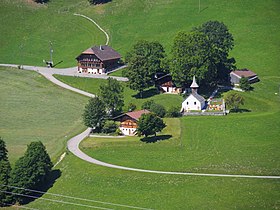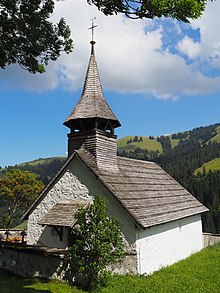Abländschen
| Abländschen | ||
|---|---|---|
| State : |
|
|
| Canton : |
|
|
| Administrative district : | Obersimmental-Saanen | |
| Residential municipality : | Saanen | |
| Postal code : | 1657 | |
| Coordinates : | 588.73 thousand / 158 390 | |
| Height : | 1309 m above sea level M. | |
| Area : | 8.74 km² | |
| Residents: | 36 (2015) | |
| Population density : | 4 inhabitants per km² | |
|
Main hamlet with church of Abländschen |
||
| map | ||
|
|
||
Abländschen is a village in the municipality of Saanen , Canton of Bern , Switzerland .
Location and landscape
The scattered settlement is in a high valley of the Jaunbach , also called Jäunli here . Only the western side of the valley belongs to the common Saanen; the eastern half of the valley with the Hundsrügg (2047 m above sea level ) and the Jaunpass (1509 m above sea level) belongs to the Simmental community of Boltigen , the lowest section of the valley to the Freiburg community of Jaun .
The mountain village is one of the most remote places in the canton of Bern. It can only be reached via the area of the neighboring cantons, namely from Jaun (Canton Friborg) and from Saanen over the 1633 m. ü. M. high Mittelbergpass, which is only partially passable in winter, the road of which leads partly over the municipality of Rougemont in the canton of Vaud . Abländschen is located in the border area of three cantons and also in a linguistic (so-called Röstigraben ) and confessional border zone (to the Catholic canton of Friborg).
The landscape is from the Gastlosen , one between 1800 and 2200 m. ü. M. high mountain range of the Pre-Alps , dominates. Geologically it is an erected Malm layer. The spectacular limestone rock formations are a popular calendar motif.
Place name
In 1324 the place was first mentioned as Avenenchy . In 1681 Flenching and 1684 Abflentschen is attested. The name seems to be of Celtic origin and means "water-rich area".
population
| Population development | |||||||
|---|---|---|---|---|---|---|---|
| year | 1703 | 1767 | 1888 | 1910 | 1990 | 2015 | |
| Residents | 110 | 132 | 96 | 47 | 52 | 36 | |
history

In the Middle Ages , Abländschen belonged to Saanen and belonged to the county of Gruyères with Saanen . The village has had its own chapel since the 15th century.
Shortly after the Reformation , Saanen came to Bern in 1555 . In 1556, the Bernese authorities in Abländschen introduced the reformed doctrine. To ensure religious hegemony and pastoral care in the confessional border area, the chapel was retained. However, the villagers repeatedly complained about insufficient care of their remote chapel. In 1668, the Bern Council therefore decided to send a theology student to Abländschen as a preacher over the winter . In 1681 Bern had a house built for the preachers. However, since there was often still snow in summer and the way to Saanen was long and arduous, the Abländschen church was elevated to a parish church in 1704 and thus received a permanent pastor. A total of 160 pastors worked in Abländschen, which shows that the remote mountain church community was not a popular place of work for theologians and was usually quickly abandoned.
In 1664, the Bernese authorities had a cemetery built around the existing chapel, which was enlarged in 1832.
Around 1800, Pastor L. Heinrich built a mechanical sawmill on Jaunbach .
reformed Church
Building history
The 15th century chapel was extensively rebuilt in 1612–1613 and received a gallery. In 1880 the church received an oven and a harmonium , the latter financed by a donation from Kaiser Wilhelm I. It is now in the rectory. It was not until the early 20th century that the entrance to the church was moved from the east to the west.
description
The church is enclosed on three sides by the cemetery wall. The rustication -Mauern are white caught. The roof and the turret with pointed helmet are covered with characteristic wooden shingles. Four epitaphs of pastors who died in Abländschen are attached to the facade . The year 1612 is painted next to the portal.
The small interior presents itself as a slightly longitudinal , choirless rectangular hall . The church is likely to have received this typical Protestant floor plan with the renovation of 1612–1613. The benches and the gallery face the liturgy area, which is one step higher and consists of a wooden pulpit in the style of the 1950s, a communion table and an organ . A wooden cross with a Christogram is emblazoned between the two segmented arched windows of the end wall . The wooden strip ceiling is kinked in a trapezoidal shape and has simplified gothic carvings. The oldest piece of equipment is the gallery from 1612, which is provided with an artistic balustrade and inscriptions, including the year 1612 and a Christogram.
organ
The organ with its free pipe prospect was built in 1968 as Opus 61 in the organ building workshop of the brothers Felix and Kurt Wälti in Gümligen . It has a manual with 5 registers and an attached pedal . The disposition is as follows:
|
|||||||||||||
Bells
Two bells hang in the roof turret:
- Small bell (undated, Gothic decorations)
- Big Bell (1880, H. Rüetschi Foundry , Aarau )
Further architectural monuments
Economy and Infrastructure
The most important branches of business are cattle breeding, dairy farming, alpine farming and forestry to this day. However, there are only four farms left in Abländschen. In addition, gentle tourism plays a certain role.
Since the turn of the millennium, a decrease in the population and a dismantling of the infrastructure has been noted. The village's own facilities such as the school, the fire brigade and the post office were closed. The village shop and the ski lift have also disappeared. The suspension of the postbus line , which was decided against the will of the residents, is particularly decisive for the population and tourism . Abländschen is one of the few church villages in Switzerland that is not served by public transport .
The most important existing tourist facilities are the Zitbödeli restaurant , the Weisses Kreuz mountain hotel and the SAC's Grubenberghütte at 1840 m above sea level. M.
Personalities
- Giovanni Andrea Scartazzini (1837–1901) worked as a pastor in Abländschen from 1865–1869 and wrote a standard work on Dante Alighieri here .
Web links
- Website of the village organization Abländschen
- Official website of the municipality of Saanen
- Anne-Marie Dubler : Abländschen. In: Historical Lexicon of Switzerland .
Individual evidence
- ↑ Otto Rychener, Benedicht landlord, Marc Wahli: field names Obersimmental Saanenland. Saanen 1997.
- ^ A b Anne-Marie Dubler : Abländschen. In: Historical Lexicon of Switzerland .
- ↑ a b Klaus Völlmin: Abländschen Church. In: Holger Finze-Michaelsen, Klaus Völlmin: Old churches in the Simmental and Saanenland. A church guide for explorers. Pp. 110-119.
- ↑ Catalog raisonné organ building Thomas Wälti. In: Organ builder Thomas Wälti. Retrieved February 22, 2019 .
- ↑ Kerem S. Maurer: Little by little the lights go out ( Berner Zeitung online, August 12, 2015 )
- ↑ Grubenberghütte SAC











